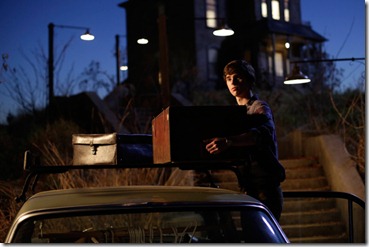How do you follow a six-season run on one of the biggest cult TV shows of all time? If you’re Carlton Cuse, you tackle the backstory of the most famous serial killer in film and TV history, Norman Bates. A&E’s newest scripted series, Bates Motel (Mondays, 10/9C), has a very promising premiere; an introduction that is both creepy and eerie without being the least bit supernatural.
Seventeen-year old Norman Bates (Freddie Highmore) discovers his father lying dead on the laundry room floor and runs to get his mother, who is, apparently just stepping out of the shower. The scene of Norman banging on the bathroom door was cut into the trailer in such a way as to make it look like he’s in a murderous rage – a very effective sell for the show, but totally misleading (a murderous rage does come later, but not from Norman).
In the teaser, the Bates home is made creepy by the overwhelming amount of photos framed on the walls of the halls – but the creepiness of the hundreds of faces in their frames barely has time register before we’re cutting to six months later and Norman’s mother, Norma (Vera Famiga), is showing him the motel they’ve bought for a song (the series is replete with all kinds of contemporary paraphernalia – cell phones, fashion, foreclosures…) – and the familiar old house that comes with it. Unfortunately, the property comes another unique feature – the drunken former owner, who claims everything on the property – or in it – is his.
In the meantime, however, Norman meets a carload of pretty girls on the way to school and gets a ride with them – with one, Bradley Martin (Nicola Pelz) forming an instant attraction for him (reciprocal, too). At school, his Language Arts teacher/Guidance Counselor, Miss Watson (genre vet Keegan Connor Tracy) sense Norman might have some issues and offers a listening ear – she also suggests he try out for the track team (Mother is not happy about that).
Norman also meets the cute cystic fibrosis sufferer and aggressively intelligent Emma Decody (Olivia Cook) – who also seems struck by the young man – in a unique manner (not exactly a ‘meet cute’).
By now, we’re getting the idea that the gangly, soft-spoken Norman is – despite his circumstances – a normal kid who’s just going through some stuff. He tries out for that track team and sneaks out to go to a party with his new friends – though he does have to do something above and beyond for any kid when he gets home.
Norma is a feisty, determined woman who seems to have the passive-aggressive administration of guilt trips down to a science – something that gives us the glimmerings of understanding about how Norman’s life is likely to go, even if we haven’t seen Alfred Hitchcock’s Psycho. To be fair, there’s an early scene where Norman is bringing a trunk in from the car and accidentally (?) sees Norma in a bra and panties, but that isn’t even half as creepy as watching the application of her emotional scalpel later.
A previously unknown member of the family, Dylan, is heard in a phone call – but we can already kind of tell that he’s a shiftless, uncentered guy whose luck borders on non-existent just from the one brief conversation. His presence in the show will undoubtedly add to the general weirdness.
Another way the mood is built is the way the Bates’ new home is in a town that seems like a modern Camelot – it’s sunny during the day and rains at night. Norman’s school is a bright, cheerful place – the exact opposite of the rundown motel he and his mother have to renovate. And that house! If ever a house screamed ‘Bad things happen here!’ it’s that house.
Interestingly enough, the Bates’ new home, White Pines Bay, holds secrets that are unrelated to them – like the notebook Norman finds in one of the motel rooms that depicts girls being subjected to abuse of all kinds – and the writing is in Japanese ideographs! This discovery is emphasized with the tiniest glimpse of…
There’s an eerie elegance to the cinematography of Bates Motel that, in combination with a pinpoint score, that gives the town of White Bay Pines a idiosyncratic uniqueness – like a Pacific Northwest Twin Peaks. In fact the town and series seem like a fusion of the perfection of Camelot with the weirdness of Lych’s cult classic.
With the show being a ‘contemporary prequel’ to the Hitchcock classic, Cuse and his writing partners are freed from any constraints and expectations a period piece would have arisen in their potential audience. They have more room to play with the characters and situations and are taking full advantage of that – as are the members of the cast. Highmore and Farmiga, especially, are brilliant.
Based on the premiere, I have to say that I am intrigued and fascinated by it – and very curious about what happens next.
Final Grade: A


